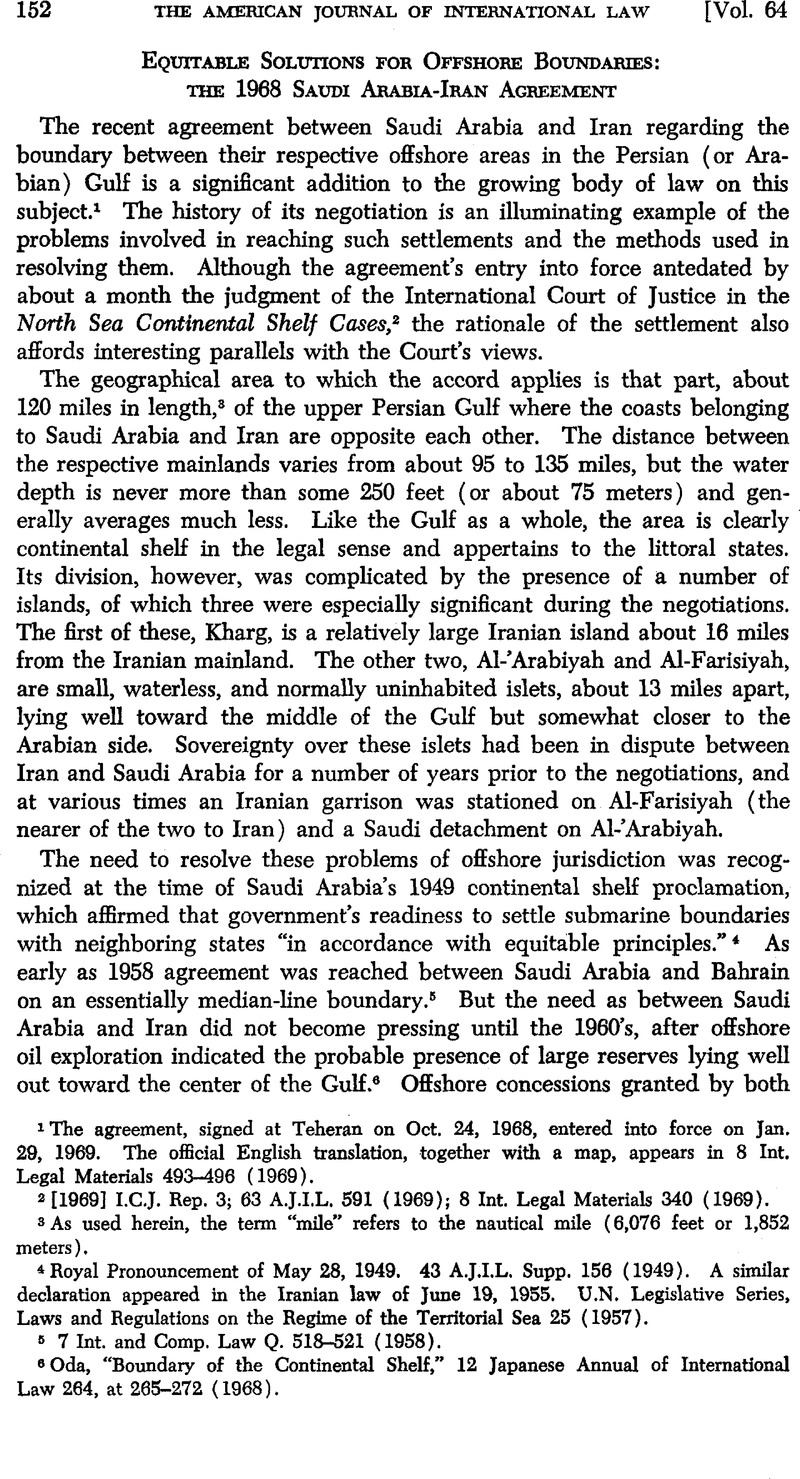Published online by Cambridge University Press: 28 March 2017

1 The agreement, signed at Teheran on Oct. 24, 1968, entered into force on Jan. 29, 1969. The official English translation, together with a map, appears in 8 Int. Legal Materials 493-496 (1969).
2 [1969] I.C.J. Rep. 3; 63 A.J.I.L. 591 (1969); 8 Int. Legal Materials 340 (1969).
3 As used herein, the term “mile” refers to the nautical mile (6,076 feet or 1,852 meters).
4 Royal Pronouncement of May 28, 1949. 43 A.J.I.L. Supp. 156 (1949). A similar declaration appeared in the Iranian law of June 19, 1955. U.N. Legislative Series, Laws and Regulations on the Regime of the Territorial Sea 25 (1957).
5 7 Int. and Comp. Law Q. 518-521 (1958).
6 Oda, “Boundary of the Continental Shelf,” 12 Japanese Annual of International Law 264, at 265-272 (1968).
7 This line, like the remainder of the final boundary, was subsequently converted for convenience to a series of lines connecting specified pairs of geographical coordinates. Fourteen such pairs were set out in Art. 3 of the agreement.
8 For accounts of these developments, with data on the resources involved, see Petroleum Intelligence Weekly, Feb. 12, 1968, p. 1; 11 Middle East Economic Survey (Beirut) No. 16 (Feb. 16, 1968), p. 1.
9 The line between Point 1 and Point 8, as described in Art. 3 of the 1968 agreement, is identical with the 1965 line. The line between Point 8 and Point 14 is the revised section.
10 Although the offshore boundary between Saudi Arabia and the Neutral Zone has not been definitively settled by formal agreement, an operating boundary between the adjacent oil concessions has been observed for a number of years with the sanction of both the Saudi Arabian and Kuwait Governments. It was the prolongation of this line which fixed the northerly limit of the Saudi Arabia-Iran boundary.
11 Middle East Economic Survey, No. 43 (Aug. 23, 1968), p. 1.
12 Nautical charts of the Gulf, though much improved in recent years, were found to lack accurate shoreline detail in areas not important for navigation, and to have other shortcomings for delimitation purposes.
13 On the Iranian side, the low-water line had been mapped in the 1950's and 1960's with a high degree of accuracy as an incident of determining the boundaries between onshore and offshore oil concessions. See Daneshvar and Perret, ‘Identification de limites dans les eaux territoriales iraniennes du Golfe Persique” (paper given at the Conference on Petroleum and the Sea, Monte Carlo, May, 1965).
14 Remarks of Robert Hodgson (Office of the Geographer, Department of State) at 3d Annual Conference of the Law of the Sea Institute, University of Rhode Island, June 24-27, 1968. Conference Proceedings 202 (1969).
15 [1969] I.C.J. Rep. 54; 63 A.J.I.L. 631 (1969); 8 Int. Legal Materials 384 (1969).
16 [1969] I.C.J. Rep. 51-52; 63 A.J.I.L. 629-630 (1969); 8 Int. Legal Materials 382-383 (1969).
17 [1969] I.C.J. Rep. 53; 63 A.J.I.L. 631 (1969); 8 Int. Legal Materials 384 (1969).
18 Negotiations regarding several of these boundaries are now under way, and in some cases (notably Kuwait-Iran) are reportedly well advanced. The Iraq-Iran offshore boundary, technically interesting because of its resemblance to the North Sea situation dealt with by the International Court, is complicated by the current conflict over the river boundary between the two countries in the Shatt al-Arab.